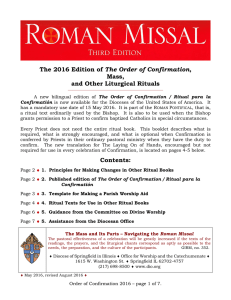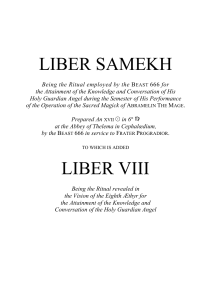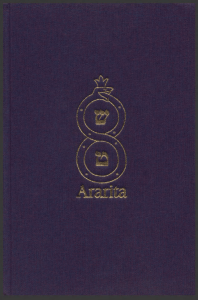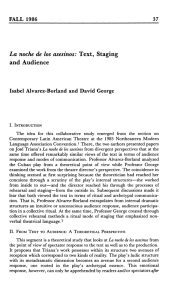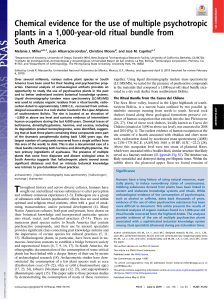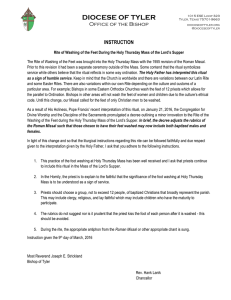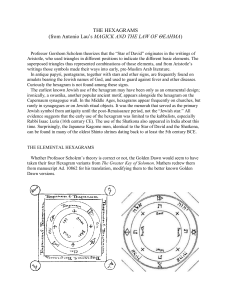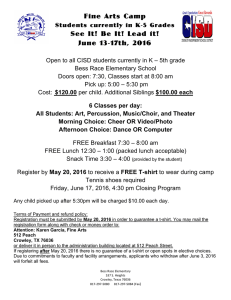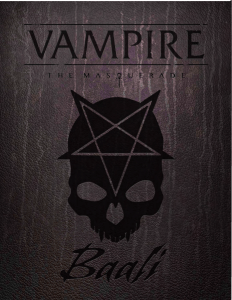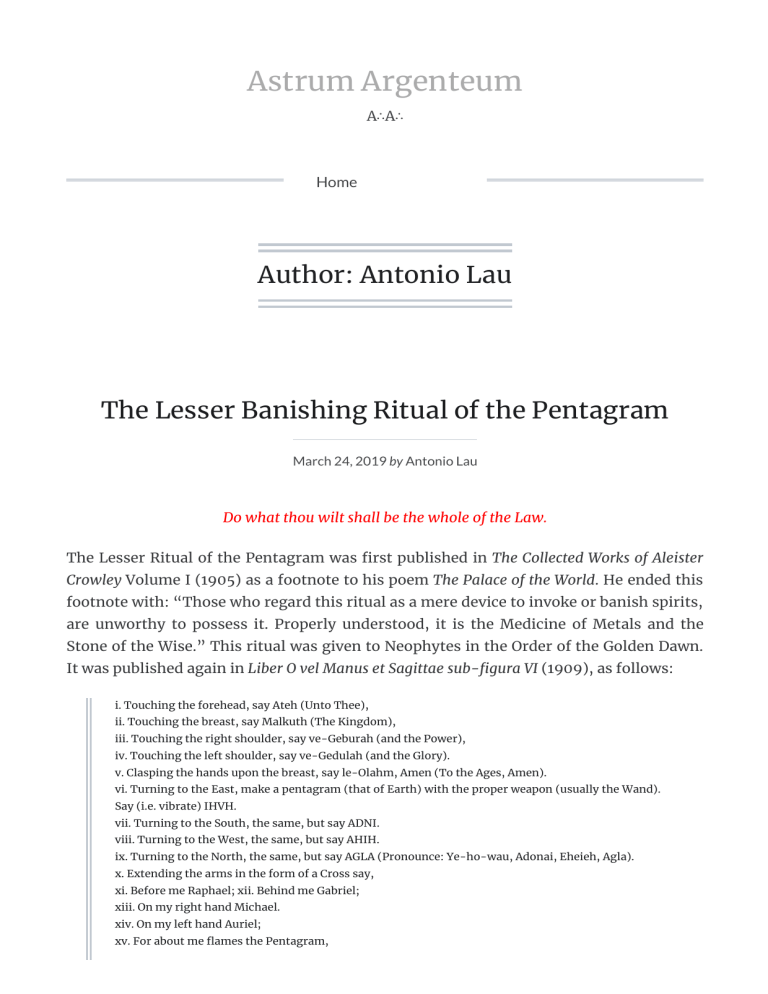
Astrum Argenteum A∴A∴ Home Author: Antonio Lau The Lesser Banishing Ritual of the Pentagram March 24, 2019 by Antonio Lau Do what thou wilt shall be the whole of the Law. The Lesser Ritual of the Pentagram was rst published in The Collected Works of Aleister Crowley Volume I (1905) as a footnote to his poem The Palace of the World. He ended this footnote with: “Those who regard this ritual as a mere device to invoke or banish spirits, are unworthy to possess it. Properly understood, it is the Medicine of Metals and the Stone of the Wise.” This ritual was given to Neophytes in the Order of the Golden Dawn. It was published again in Liber O vel Manus et Sagittae sub- gura VI (1909), as follows: i. Touching the forehead, say Ateh (Unto Thee), ii. Touching the breast, say Malkuth (The Kingdom), iii. Touching the right shoulder, say ve-Geburah (and the Power), iv. Touching the left shoulder, say ve-Gedulah (and the Glory). v. Clasping the hands upon the breast, say le-Olahm, Amen (To the Ages, Amen). vi. Turning to the East, make a pentagram (that of Earth) with the proper weapon (usually the Wand). Say (i.e. vibrate) IHVH. vii. Turning to the South, the same, but say ADNI. viii. Turning to the West, the same, but say AHIH. ix. Turning to the North, the same, but say AGLA (Pronounce: Ye-ho-wau, Adonai, Eheieh, Agla). x. Extending the arms in the form of a Cross say, xi. Before me Raphael; xii. Behind me Gabriel; xiii. On my right hand Michael. xiv. On my left hand Auriel; xv. For about me ames the Pentagram, xvi. And in the Column stands the six-rayed Star. xvii-xxi. Repeat (i) to (v), the Qabalistic Cross. It is generally assumed that this ritual was created by S. L. MacGregor Mathers for the Golden Dawn. However, it would seem that the main prototype for the Qabalistic Cross comes from Eliphas Levi’s Transcendental Magic [translated by A. E. Waite]: For example, the initiate said raising his hand to his forehead, “For thine,” then added “is,” and continuing as he brought down his hands to his breast, “the kingdom,” then to the left shoulder, “the justice,” afterwards to the right shoulder, “and the mercy” – then clasping his hands, he added, “in the generating ages.” Tibi sunt Malkuth et Geburah et Chesed per aeonas – a Sign of the Cross which is absolutely and magni cently kabalistic, which the profanations of Gnosticism have completely lost to the o cial and militant Church. This sign, made after this manner, should precede and terminate the Conjuration of the Four. “The Conjuration of the Four” was an elaborate ritual of prayers designed to evoke the Elementals of Paracelsus: Sylphs (Air) in the East, Salamanders (Fire) in the South, Undines (Water) in the West, and Gnomes (Earth) in the North. Just before the above quote, the text read: “holding the Pantacle of Solomon in one hand and taking up successively the sword, rod and cup, the Conjuration of the Four should be recited with a loud voice…” Although these exact instructions might be loosely interpreted, one could easily imagine the “Pantacle of Solomon” to be the same as that Pentagram of Solomon described in The Goetia (the Lesser Key of Solomon) as such: “the gure whereof is to be made in Sol or Luna (Gold or Silver), and worn upon thy breast; having the Seal of the Spirit required upon the other side thereof. It is to preserve thee from danger, and also to command the Spirits by.” Compare this to Levi’s own instructions in Transcendental Magic: The sign of the Pentagram should be composed of the seven metals, or at least traced in pure gold upon white marble. It may be also drawn with vermilion on an unblemished lambskin the symbol of integrity and light… The Pentagram is consecrated with the four elements; the magical gure is breathed on ve times… The ve breathings are accompanied by the utterance of names attributed to the ve genii, who are Gabriel, Raphael, Anael, Samael and Oriphiel. Afterwards the Pentacle is placed successively at the north, south, east, west and centre of the astronomical cross, pronouncing at the same time, one after another, the consonants of the Sacred Tetragram… Although there are some obvious di erences between Levi’s instructions and those of the Golden Dawn’s Pentagram rituals, it is highly likely that those particular quotes from Transcendental Magic were a major in uence. Furthermore, since Levi’s handwriting can be found in the Cipher manuscripts, as well as directions for drawing the elemental Pentagrams, there is the possibility that the Pentagram ritual of the Golden Dawn (in all its variations) might have already been in use before the Order was actually established. So, it is entirely plausible that Levi might have been alluding to this very ritual, couched in the typical blinds he was known to use in order to protect his oaths of secrecy. (i-v) The Qabalistic Cross It should be readily apparent that the di erence between the Roman Catholic Sign of the Cross and the Qabalistic Cross is the wording. The former uses the usual Trinitarian formula (“In the Name of the Father and the Son and the Holy Spirit”); the latter replaces this with the doxology of the Lord’s Prayer (“Thine is the Kingdom, and the Power, and the Glory forever”) liberally translated into Hebrew to correspond to the Tree of Life. On page 37 in Liber 777, we are informed that Chesed has the additional title of Gedulah, which means “Majesty.” Perhaps this alternative title of the Sephiroth was chosen by Mathers to maintain balance with Geburah, since both have the same number of syllables, just as Ateh and Malkuth have two. In his book The Middle Pillar, Israel Regardie claims: “The tradition holds that these words should be vibrated and not merely enunciated.” However, this “tradition” did not begin the original Golden Dawn; it probably began with Golden Dawn o shoot the Stella Matutina, if not Regardie himself. In fact, the Z1 document of the Golden Dawn gives a solemn warning: when using the “traditional mode of pronouncing the Divine Names by vibration, let the Adept beware that he applies it only to the Divine Names of the Gods.” THE WORDS OF THE QABALISTIC CROSS ARE NOT THE DIVINE NAMES OF THE GODS. It is just as e cient to adhere to the typical Catholic method of hand gesturing; the beginner might even learn rst by saying the words in English: “Thine is the Kingdom, and the Power, and the Glory forever. Amen!” Repeating this a few times until it feels natural enough, one could then move on to the Hebrew: “Ateh Malkuth, ve-Geburah, veGedulah le-Olahm. Amen!” This is a case in which one raised as a Catholic probably has an advantage, one who already spent years treating the Sign of the Cross as a magical gesture of both protection and sanctity. Vibrating the words of the Qabalistic Cross is certainly not necessary at all, but the individual practitioner may be left to use their own discretion toward deciding whether this augmentation is worth the bother. In the rst issue of Phyllis Seckler’s In The Continuum, part (ii) was changed to: “Touching the breast, say Aiwass; Touching the genitals, say Malkuth” and the rest follows as in (iii-v). Although it doesn’t appear in any of Crowley’s published writings, evidence that he may have implemented this addition can be found in the autobiography of Betty May (Tiger Woman: My Story), where she describes her stay at the Abbey of Thelema: Clouds of incense hung about the room everywhere. When all were assembled, the Mystic rose from his seat, and taking one of the swords from the side of the brazier, held it pointing towards the altar while he intoned an invocation in a language with which I was not familiar. From hearing it every day, however, the sounds remain xed in my memory. “Artay I was Malcooth — Vegabular, Fagedura, eear-la — ah moon.” The last was a high-pitched note in contrast with the rest of the chant. [We can surely assume that “Ateh Aiwass Malkuth—ve-Geburah, ve-Gedulah, le Olahm — Amen” was what she actually heard.] As the original version uses the inverted Cross of Saint Peter, it is interesting to note that this Cefalu era modi cation is a closer t to the original Golden Dawn Rose Cross and the Minutum Mundum (the Tree of Life in color). In Liber 777 column XXI, Crowley changed the attribution of Malkuth on the body from the feet (in the tradition of Mathers and Westcott) to the anus and buttocks. One could easily see how the Complete Symbol of the Rose and Cross would correspond to the human body, by this new attribution, in due proportion and symmetry. The Rose and Cross being united, they bring down into the centre of all the Divine White Brilliance of Kether, in which is shown another Rose Cross, no longer of divided light, but Ruby of the Holy Spirit; of Gold, the Glory of the Light; of Green rays because Isis shines forth—a new Creation. This higher Rose Cross is again the mystery of the Higher Genius descending into Kether, when the Lower is in Tiphereth established. [The Equinox III:3 page 225] Although the points of Malkuth, Geburah, and Chesed are directly referred to by name, it should be noted that Ateh does not, and at the forehead does not touch on any speci c Sephirah on the body. Rather, it touches on the path of Gimel, directly in the center of the Supernal triad and enclosed by the paths of Aleph, Beth and Daleth. In the footnotes to The Palace of the World, Crowley explains that the Moon on the forehead “signi es Aspiration to the Highest.” The importance of this signi cance is repeated several times in his writings. In Liber 333, we have “3, silver and the moon, are all correspondences of Gimel, the letter of the Aspiration, since Gimel is the Path that leads from the microcosm in Tiphareth to the Macrocosm in Kether.” And, “The card Gimel in the Tarot is the High Priestess, the Lady of Initiation; one might even say, the Holy Guardian Angel.” And again, “The ‘moon-pool of silver’ is the Path of Gimel, leading from Tiphareth to Kether; the ‘ ames of violet’ are the Ajna-Chakkra…” This last quote is from chapter 65, and “65 is the number of Adonai, the Holy Guardian Angel.” It should also be noted that Ajna is generally located on the forehead, as “the Third Eye.” The Moon (being the general feminine symbol, the symbol of the second order corresponding to the Sun as the Yoni does to the Lingam) is universal, and goes from the highest to the lowest. It is a symbol which will recur frequently in these hieroglyphs. But in the earlier Trumps the concern is with Nature above the Abyss; the High Priestess is the rst card which connects the Supernal Triad with the Hexad; and her path, as shown in the diagram, makes a direct connection between the Father in his highest aspect, and the Son in his most perfect manifestation. This path is in exact balance in the middle pillar. [The Book of Thoth] But there is no need to emulate Crowley’s Aiwass addition; my own personal preference is to bypass the breast point and go from forehead with Ateh directly down to genitals with Malkuth, which also re ects a similarity to the gestures of Liber XXV’s “Cross Qabalistic.” The practitioner begins the ritual facing East. Even though Liber O claims to have taken “the most minute critical care” in the preparation of the book, one can easily mistake the directions of the Lesser Ritual of the Pentagram based on the exact wording. Some have thought it was meant that one was to begin by facing North. In the early A∴A∴, the Neophyte would have taught his or her Probationer the ritual properly, or any mistake would have been corrected soon enough. From the very beginning, I have personally interpreted “vi. Turning to the East” to mean “turn your attention speci cally outward to the Eastern quarter” whereas the Qabalistic Cross was more of a centered gesture aimed inward rather than outward. Crowley sent his Notes on the Ritual of the Pentagram to Karl Germer in a letter dated December 11, 1946. Circulated among Agape Lodge members, including Jane Wolfe and Grady McMurtry, these also came to be published in Phyllis Seckler’s rst issue of In The Continuum. They begin as follows: You are supposed to be standing at the intersection of the paths of Samekh and Peh. You are facing Tiphareth (the Sun), thus on your right hand is Netzach (Venus) on your left hand Hod (Mercury), and behind you Yesod (the Moon). In the Neophyte Ritual of the Golden Dawn, according to the Z1 document, “The place of the Hegemon is between the two pillars, whose bases are in Netzach and Hod at the intersection of the paths of Peh and Samekh in the symbolic gateway of the Occult Science.” The Hegemon is “the representative of the Gods of Truth and Justice” and “the translator of the Higher Self” who prepares the Candidate, leads the Candidate, and speaks for the Candidate during his initiation. It is at the intersection of Samekh and Peh that the Initiate gets his fourth and nal consecration as a Neophyte. [See Diagram 3 of The Temple of Solomon the King.] The Lesser Ritual of the Pentagram was given to the Neophyte of the Golden Dawn. (vi-ix): The Pentagrams and the Vibration of God Names The Pentagram of Earth may have rst appeared in the Cipher Manuscripts folio 10. Publication for Probationers, “Issued by authority of the Master Therion” and distributed by Frater Progradior (Frank Bennett), included precise instructions on how to make the Banishing Pentagram of Earth. [In the Lesser Ritual of the Pentagram, ONLY the Pentagram of Earth is used, and it is used in all four quarters.] These instructions are as follows: To make the Pentagram, act thus: Bring the right hand, with fore nger extended, towards the outer side of left hip. (a) Sweep it upwards till vertically in front of centre of head. (b) Sweep it downwards towards outer side of right hip. (c) Sweep across and upwards towards the outer side of left shoulder. (d) Straight across towards outer side of right shoulder. (e) Across and downwards towards outer side of left hip, or starting point. Thus, that symbol of Great Power, the Five Pointed Star, is traced in the air. In doing this gure, the arm must be kept quite rigid throughout; and in turning to the Cardinal points a straight line must be drawn from Pentagram to Pentagram, by keeping the arm pointed straight outwards. We are told that in drawing the Pentagrams, we must practice until they “appear in ame, in ame so near to physical ame that it would perhaps be visible to the eyes of a bystander, were one present.” (Liber O) Although there is no suggestion of color, another modern trend has given bias to the color blue. The beginner should be very critical of these assertions, and once again, we nd that Regardie is behind this: “He must endeavor to imagine these four pentagrams as aming gures of bluish-golden hue similar to that produced by igniting methylated spirit.” Although a golden ame streaked with blue highlights is relatively innocuous, in later years this came to be further exaggerated and to “a aming, gas-jet blue” and “ aming in a bright bluewhite light.” Personal predilections aside, aiming for a general candle ame color will su ce. The full instructions for the Vibration of God-names in Liber O (section III parts 3-6) should be consulted. At this point, special attention should be given to part 4: (a) Stand with arms outstretched. [The Sign of Osiris Slain] (b) Breathe in deeply through the nostrils, imagining the name of the God desired entering with the breath. (c) Let that name descend slowly from the lungs to the heart, the solar plexus, the navel, the generative organs, and so to the feet. (d) The moment that it appears to touch the feet, quickly advance the left foot about 12 inches, throw forward the body, and let the hands (drawn back to the side of the eyes) shoot out, so that you are standing in the typical position of the God Horus, and at the same time imagine the Name as rushing up and through the body, while you breathe it out through the nostrils with the air which has been till then retained in the lungs. All this must be done with all the force of which you are capable. (e) Then withdraw the left foot, and place the right fore nger upon the lips, so that you are in the characteristic position of the God Harpocrates. This is obviously a rewording of the instructions from the Z1 document: Let the Adept, standing upright, his arms stretched out in the form of a Calvary Cross, vibrate a Divine Name, bringing with the formulation thereof a deep inspiration into the lungs. Let him retain the breath, mentally pronouncing the Name in his Heart, so as to combine it with the forces he desires to awake thereby; thence sending it downwards through his body past Yesod, but not resting there, but taking his physical life for a material basis, send it into his feet. There he shall again momentarily formulate the Name—then, bringing it rushing upwards into the lungs, thence shall he breathe it forth strongly, while vibrating that Divine Name. He will send his breath steadily forward into the Universe so as to awake the corresponding forces of the Name in the Outer World. Standing with arms out in the form of a Cross, when the breath has been imaginatively sent to the feet and back, bring the arms forward in “The Sign of the Enterer” while vibrating the Name out into the Universe. On completing this, make the “Sign of Silence” and remain still, contemplating the Force you have invoked. “The Sign of the Enterer” is the same as “the typical position of the God Horus” and the “Sign of Silence” is “the characteristic position of the God Harpocrates” in Liber O. Also, compare this paragraph with the next: “It is a sign of success, though only by the student himself is it perceived, when he hears the name of the God vehemently roared forth, as if by the concourse of ten thousand thunders; and it should appear to him as if that Great Voice proceeded from the Universe, and not from himself.” (Liber O) From section III part 4 (d) of Liber O, many interpret “imagine the Name as rushing up and through the body, while you breathe it out through the nostrils with the air which has been till then retained in the lungs” as meaning that the Vibration of the God-name is not physically vocalized out loud. Perhaps that is exactly what Crowley meant, but other instructions were clearer and simpler: “intone the name IHVH, pronounced YeHo-Wau, imagining that it rushes forward with the breath. Vibrate this name with a strong voice, imagining that the voice carries to in nity in the east.” [These instructions (dated January 15, 1947) are currently unpublished.] Vibrating silently/mentally is certainly a practical option if the magician lives with others who don’t also practice Magick, and rarely has the chance to be completely alone in the house. Every magician is free experiment with either method (or both) to nd which works best for them. But regardless of which method is chosen, it is of the utmost importance to heed the statement: “All this must be done with all the force of which you are capable.” The outward intonation and/or projection of each God-name should only take about 3 or 4 seconds. Notes on the Ritual of the Pentagram continues with: You take one step with the right heel in the hollow of the left foot towards Tiphareth and vibrate the Divine Name as given in the ritual. You then carry round the point of the Wand towards Netzach, then take a step again (always recovering after each forward step so that you remain in the centre) and vibrating the Divine Name as before. Continue the process facing Yesod and vibrating; then Hod, and vibrating; but carry the point of the Wand round to Tiphareth so as to complete the circle. When you begin, you should be standing with your feet a few inches apart. Just as the Godname touches your feet, your right foot pivots clockwise; the big toe goes from 12 o’clock to 3 o’clock and the heel is at 9 o’clock, where it will be in the hollow of the left foot. This is the moment that you bring your hands up to the side of the eyes, just before you advance the left foot about 12 inches. Notice the position of Crowley’s right foot in the Blind Force photo (above). [Where it says Wand, beginners should use the fore nger as stated in Frater Progradior’s instructions. Later, the Magick Dagger may be used for banishings.] In his introduction to The Kabbalah Unveiled (also quoted in Liber LVIII), Mathers brie y discusses the four tetragrammatic names: The name of the Deity, which we call Jehovah, is in Hebrew a name of four letters, IHVH; and the true pronunciation of it is known to very few… Therefore when a devout Jew comes upon it in reading the Scripture, he either does not attempt to pronounce it, but instead makes a short pause, or else he substitutes for it the name Adonai, ADNI, Lord. The radical meaning of the word is “to be,” and it is thus, like AHIH, Eheieh, a glyph of existence… [AGLA] is not, properly speaking, a word, but is a notariqon of the sentence, AThH GBVR LOVLM ADNI, Ateh Gebor Le-Olahm Adonai: “Thou are mighty for ever, O Lord!” A brief explanation of Agla is this: A, the one rst; A, the one last; G, the Trinity in Unity; L, the completion of the great work… Therefore, as the Son reveals the Father, so does IHVH, Jehovah, reveal AHIH, Eheieh. And ADNI is the Queen “by whom alone Tetragrammaton can be grasped,” whose exaltation into Binah is found in the Christian assumption of the Virgin. According to Liber 777 and Liber O, IHVH is the God-name of Air, ADNI is the God-name of Earth, AHIH is the God-name of Spirit (Active) and AGLA is the God-name of Spirit (Passive). The God-names of Fire (ALHIM) and Water (AL) are not used in the Lesser Ritual of the Pentagram at all, just as only the Pentagram of Earth is used. However, it should be noted that in the Greater Ritual of the Pentagram, the magician begins by drawing in the East the Pentagram of Spirit (Active) and then the Pentagram of Air. In the North, after using the appropriate Pentagrams and God-names in the South and West, he draws the Pentagram of Spirit (Passive) followed by the Pentagram of Earth. It is of the utmost importance that one studies these variations, as complicated and confusing as they are. Mathers gave another vibratory formula in Telesmatic Images and Adonai (as follows), but it would seem that Crowley, along with George Cecil Jones, felt it wasn’t all that necessary to teach it to the Probationer, preferring to exclusively use the Z1 formula in Liber O. The ordinary mode of vibrating is as follows: Take a deep and full inspiration and concentrate your consciousness in your heart, which answers to Tiphareth. (Having rst ascended to your Kether, you should endeavour to bring down the white Brilliance into your heart, prior to centering your consciousness there.) Then formulate the letters of the Name required in your heart, in white, and feel them written there. Then, emitting the breath, slowly pronounce the Letters so that the sound vibrates within you, and imagine that the breath, while quitting the body, swells you so as to ll up space. Pronounce the Name as if you were vibrating it through the whole Universe, and as if it did not stop until it reached the further limits. (x-xvi): The Archangels and the Column It is alleged that this part of the ritual originated as a Jewish prayer, documented by Rabbi Samson Raphael Hirsch in The Hirsch Siddur: “In the Name of God, the God of Yisrale: may Michael be at my right hand, Gabriel at my left, Uriel before me, Raphael behind me, and above my head, the presence of God.” Joshua Trachtenberg, commenting on the above prayer, writes: “This is nothing more than a Jewish version of the ancient Babylonian incantation, ‘Shamash before me, behind me Sin, Nergal at my right, Ninib at my left’…” (Jewish Magic and Superstition) [Note that Shamash is the Sun, Sin the Moon, Nergal Mars, and Ninib Saturn.] In Heinrich Cornelius Agrippa’s Second Book of Occult Philosophy (1533), Michael is the Archangel of Fire in the East, Gabriel is the Archangel of Water in the North, Raphael is the Archangel of Air in the West, and Uriel is the Archangel of Earth in the South. Here it gets tricky, and a bit confusing. 1. The positions of the archangels in the Ritual of the Pentagram are clearly di erent than those of Hirsch or Agrippa, but their assigned Elements in the ritual ARE consistent with Levi’s Conjuration of the Four. 2. Raphael is also the archangel of Tiphareth, and Gabriel is the archangel of Yesod (Liber 777 column XCIX); this would be consistent with Notes on the Ritual of the Pentagram. However, in his footnotes to The Palace of the World, Crowley writes: “Michael, Lord of Hod, an Emanation of a watery nature” and “Auriel, Archangel of Netzach, to which re is attributed.” But Michael is the Archangel of Fire and he is at the right hand, where Netzach is supposed to be. And in Liber 777, the Archangel of Netzach is Haniel (“Joy of God”) while Auriel (“Light of God”) is not attributed to any of the Sephiroth. So we have to assume that the young poet Crowley was trying to force a square peg into a round hole. 3. With the exception of IHVH/Raphael/Air, the other God-names, Archangels and Elements do not match up with their traditional correspondences. At best, I can only guess that the Elements are all supposed to be counter-balanced with each other in one way or another, intentionally or by accident. The Golden Dawn (Regardie’s Stella Matutina book) o ers this explanation: The elements vibrate between the Cardinal points for they have not an unchangeable abode therein, though they are allotted to the Four Quarters in their invocation in the Ceremonies of the First Order. This attribution is derived from the nature of the winds. For the Easterly wind is of the Nature of Air more especially. The South Wind bringeth into action the nature of Fire. West winds bring with them moisture and rain. North winds are cold and dry like Earth. The S.W. wind is violent and explosive — the mingling of the contrary elements of Fire and Water. The N.W. and S.E. winds are more harmonious, uniting the in uence of the two active and passive elements. Yet their natural position in the Zodiac is: Fire in the East, Earth in South, Air in West, and Water in the North. Therefore they vibrate: Air between West and East. Fire between East and South. Water between North and West. Earth between South and North. Spirit also vibrateth between the Height and Depth. However, it seems more likely that the order of the Elements of the Archangels — Air/East, Fire/South, Water/West, Earth/North — follow the formula of F.I.A.T. “Only in the end shalt thou give up thy sap when the great God F.I.A.T. is enthroned on the day of Be-With-Us.” (Liber A’ash) According to Liber LVIII: “F.I.A.T. is Flatus, Ignis, Aqua, Terra; showing the Creator as Tetragrammaton, the synthesis of the four elements; showing the Eternal Fiat as the equilibrated powers of Nature.” Flatus means air, Ignis means re, Aqua means water, and Terra means earth. Since the founders of the Hermetic Order of the Golden Dawn were all originally members of Societas Rosicruciana In Anglia, it is very likely that they simply took this arrangement from that Order’s Theoricus ritual: The four Ancients are seated at the centre of the Temple, behind their pillars, each facing his own cardinal point, thus forming the Cross of the Four Elements: The Ancient of Earth, clothed in a black robe, faces North. The Ancient of Water, in a blue robe, faces West. The Ancient of Air, in a yellow robe, faces East. The Ancient of Fire, in a red robe, faces South. It is also interesting to note that the passwords are “Fortitude” for Air, “Ignigene” for Fire, “Aquaticus” for Water, and “Terrigena” for Earth in this ritual, where it is proclaimed that these are speci cally associated with the word F I A T. The ritual also states: This Cross is named the Cross of the Elements; it consists of a central white square and four arms of equal length around it. They are coloured Red, Blue, Yellow and Black, the Red of Fire is above, the Black of Earth is below, the Blue of Water is on the right, and the Yellow of Air is on the left; this is the position of the four Ancients in the Temple in this Grade. In The Magus (1801), Francis Barrett’s translation of Trithemius states: “get a small plate of pure gold… On the other side of the plate let there be engraven ‘Michael, Gabriel, Uriel, Raphael;’ which are the four principal angels ruling over the Sun, Moon, Venus and Mercury…” Crowley ends Notes on the Ritual of the Pentagram with: You can gure out for yourself the forms of the angels, or rather Archangels. For instance, Raphael, commencing with an “R” will have a head of solar glory and the Peh which follows shows that the rest of him is martial: the “AL” which concludes the name (in the case of most angelic beings) indicates that they wield the sword and the balance. By “AL” he means Aleph/Air/the Sword and Lamed/Libra/the Balance (as in the Scales of Justice). Resh, the rst letter of Raphael, corresponds to the Sun. Gimel, the rst letter of Gabriel, corresponds to the Moon. Michael (Archangel of Fire) begins with Mem (attributed to Water), as Auriel (Earth) begins with Aleph (Air). If Peh would make the rest of Raphael martial, one could assume he has the body of a warrior. Auriel might have beefy shoulders (Vau/Taurus) and classic chiseled torso (Resh/Sol), with legs that are both feminine and sturdy (Yod/Virgo). Gabriel, having the same torso and legs as Auriel but with Mercurial arms, could give an impression of a typical swimmer’s body. If we imagine Michael as having a “Watery” face (Mem – feminine and re ective), but with an androgynous torso (Yod/Virgo) and powerful legs (Kaph/Jupiter), we could easily see how accurate he is portrayed in Guido Reni’s famous painting. We can easily imagine the attire of all four Archangels as being similar to Reni’s Michael. But whereas he has a red cloak, I also personally imagine that the cloak of Raphael is yellow, that of Gabriel blue, and Auriel’s green. A popular modern Golden Dawn tradition has Michael with Wand, Gabriel with Cup, Raphael with Sword and Auriel with Pentacle, but this de es BOTH traditional representation AND Crowley’s suggestion. W. B. Yeats himself painted Auriel with sword and shield. [I’m not sure why Yeats gave him a red cloak, although my best guess is that it is supposed to be the redorange of Vau, the second letter of Auriel’s name.] In the Golden Dawn Ritual of the Pentagram, the initiate then says: “Before me ames the Pentagram, and behind me shines the six-rayed Star.” When Crowley changed the words, he also introduced a slightly di erent magical formula, The Palace of the World: “It rst in footnote 18 from ames both above and beneath the magus, who is thus in a cube of 4 pentagrams and two hexagrams, 32 points in all. And 32 is AHIHVH, the sacred word that expresses the Unity of the Highest and the Human.” Then again in Notes on the Ritual of the Pentagram: “You are thus standing in a Column which is protected by your microcosmic invocation. The consequent result, being macrocosmic response, is that without any e ort on your part the hexagram or sixfold star appears both above and below you.” Oddly enough, Crowley designed the A∴A∴ Probationer’s robes with a scarlet Pentagram in front, and a Hexagram on the back similar to the Golden Dawn Banner of the East. It seemed to me that the idea originally came from the image of the three pillars of the Tree of Life from the Golden Dawn 4=7 ritual; this image is reproduced in The Equinox I:2 but the pillars are called Columns. “And in the Column stands the six-rayed Star.” “Tiphereth (6) is the Hexagram, harmonizing, and mediating between Kether and Malkuth.” [Liber ABA, part 3] The image in the diagram would logically appear to contradict the notion of a Hexagram above and below. Instead we get the notion that there should only be one Hexagram that “stands,” at Tiphareth, “in the Column”; but that would bring the number of points to 26. A third Hexagram added to Crowley’s 2 would make the Qabalistic total 38. However, Liber VIII might provide an explanation: “secretly the blue triangle that descendeth is Nuit, and the red triangle that ascendeth is Hadit.” That is, if this Hexagram represents Nuit and Hadit, who are generally attributed to Ain and Ain Soph, the number of this third and middle Hexagram would represent the Qabalistic Zero. 5+5+5+5+6+6+0=32, the number of AHIHVH. In Liber LVIII, we read: “But rst of all it strikes us that I, A, and O are the three Letters associated with the three Letters H in the great Name of Six Letters, AHIHIVH, which combines AHIH and IHVH, Macroprosopus and Microprosopus.” In the drawing of AHIHVH in Hexagram form (The O of IAO given as Vau or V), note that Heh (H) ascribed to all three points of the descending triangle. “The letter Heh is the formula of Nuit” [Liber ABA part 3], just as “the blue triangle that descendeth is Nuit.” The conclusion would be that all the points of the Lesser Ritual of the Pentagram (32) on the whole create another Hexagram that symbolizes the Qabalistic Zero, radiating from the center of the Column and ooding the whole Circle with the Limitless Light of Ain Soph Aur. And the Hexagram is the formula of unifying opposites (positive and negative, active and passive, male and female), by the 0=2 Equation. Regardless of what conclusion can be made of it, to me the Column is formed from the inner hexagon of the Hexagrams both above and below, creating a transparent light not unlike glass walls lit from the inside. Likewise, this Column ts perfectly within that cube upon whose four other sides is the Pentagram. Crowley refers to the Flaming Sword as the Pentagram unwound. “The Flaming Sword follows the downward course of the Sephiroth, and is compared to the Lighting Flash. Its hilt is in Kether and its point in Malkuth.” [Liber 777 column IX] Spirit is attributed to Kether; Fire to Chokmah; Water to Binah; Air to the six Sephiroth from Chesed to Yesod, though concentrated in Tiphareth; Earth to Malkuth. Chesed and Hod are also attributed to Water, Geburah and Netzach to Fire, Tiphareth and Yesod to Air in yet another arrangement. The Five Parts of the Soul also correspond to both the Sephiroth and Elements: 1) Jechidah, the Self; 2) Chiah, the Life Force; 3) Neshamah, the Intuition; 4-9) Ruach, the Intellect; 10) Nephesh, the Animal Soul which perceives and feels. These concepts, along with the union of Macrocosm and Microcosm by way of AHIHVH, should also be taken into consideration in order to properly understand how this ritual “is the Medicine of Metals and the Stone of the Wise.” Regular Practice “Neglect not the Performance of the Ritual of the Pentagram, and of the Assumption of the Form of Hoor-pa-Kraat.” (Liber Aleph) The novice of Magick who accepts the Law of Thelema should memorize the Lesser Banishing Ritual of the Pentagram as soon as possible, then practice it every day for at least an entire year. According to Liber O, the Pentagrams (and circle connecting them) should “appear in ame, in ame so near to physical that it would perhaps be visible to the eyes of a bystander, were one present.” Then, the Thelemite should study and eventually learn to perform Liber XXV; many have chosen to replace the Liber O version with that of Liber XXV, or to even bypass the former altogether. Whatever one choses to do, it is essential that the other Pentagrams in Liber O are committed to memory for later use in astral work, Liber V vel Reguli, Liber Samekh, and other magical practices such as those of Liber Chanokh. There are those among certain Thelemic circles who insist that the Lesser Banishing Ritual of the Pentagram in Liber O and that of Liber XXV are completely separate rituals, used for completely di erent purposes. But Crowley’s very words suggest otherwise. Magick in Theory and Practice, Appendix I, Section 3 clearly de nes Liber XXV as “An improved form of the lesser ritual of the Pentagram.” Below, in these two quotes from Magick in Theory and Practice, the rst quote implies that the student is given an option between the two forms, and the second quote speci cally states “ ‘The Banishing Ritual of the Pentagram’ (AS NOW REWRITTEN, Liber 333, Cap. XXV) IS THE BEST TO USE.” The habitual use of the Lesser Banishing Ritual of the Pentagram (say, thrice daily) for months and years and constant assumption of the God-form of Harpocrates (See Equinox I, II and Liber 333, cap. XXV for both of these) should make the “real circle”, i.e. the Aura of the Magus, impregnable. It is usually su cient to perform a general banishing, and to rely upon the aid of the guardians invoked. Let the banishing therefore be short, but in no wise slurred — for it is useful as it tends to produce the proper attitude of mind for the invocations. “The Banishing Ritual of the Pentagram” (as now rewritten, Liber 333, Cap. XXV) is the best to use. Love is the law, love under will. From Antonio Lau’s Magick And The Law of ΘEΛHΜΑ) Posted in Uncategorized Search … Recent Posts Liber B vel Magi sub gura I December 6, 2019 Comments on Liber Pyramidos September 23, 2019 On the Magical Motto September 23, 2019 The Grades Correspondences September 23, 2019 Initiation: The Hidden Agenda of Being March 25, 2019 Archives December 2019 September 2019 March 2019 September 2017 March 2017 December 2016 September 2016 Search March 2016 Categories Select Category
